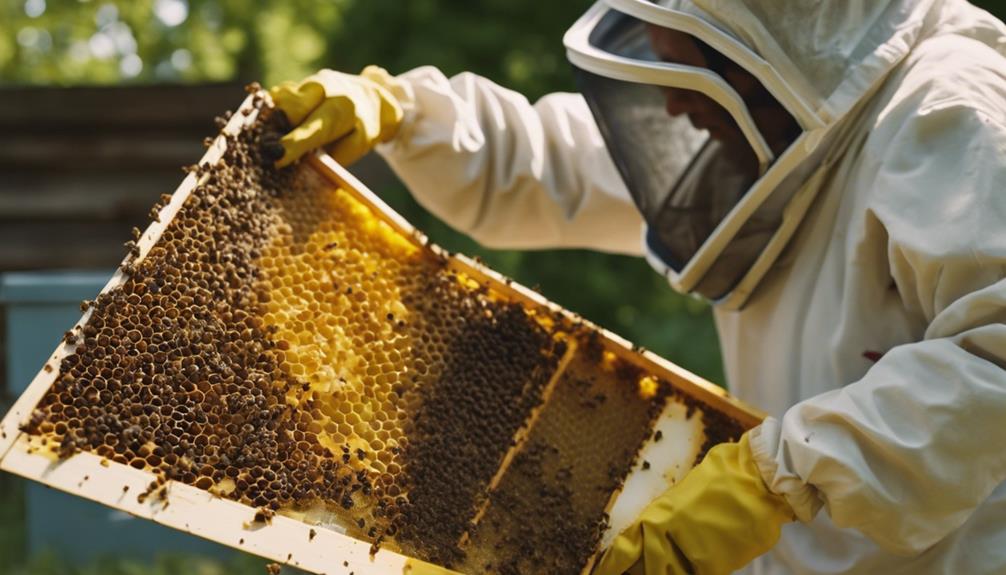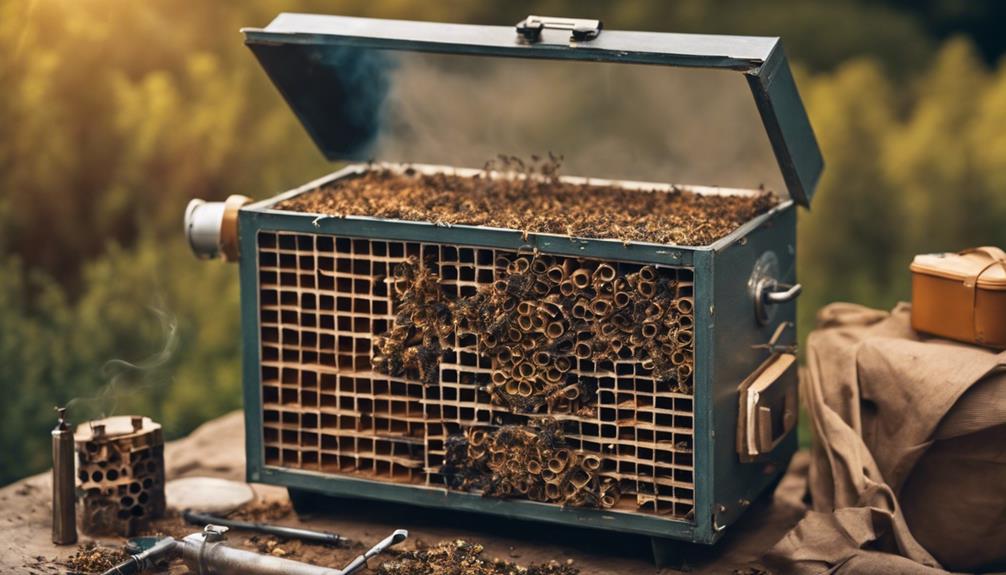Carniolan bees are quite aggressive in defending their hive, relying on their potent venom and swarm protection tactics to shield against potential threats. Their dedication to safeguarding the colony is unparalleled, making them formidable defenders. Understanding their defensive behavior is essential for beekeepers to manage hive health effectively and guarantee safety. If you want to learn more about Carniolan bees and their fascinating traits, delve deeper into their temperament and unique characteristics.
Main Points
- Carniolan bees exhibit aggressive defensive behavior.
- They utilize their sting as a potent tool for defense.
- Swarm protection behavior is a key aspect of their aggression.
- Their venom potency levels contribute to their defensive nature.
- Understanding their aggression is crucial for effective hive management.
Carniolan Bees Temperament
Carniolan bees exhibit a distinct temperament that sets them apart from other bee species, particularly in their defensive behavior towards beekeepers. These bees are known for being more aggressive compared to Italian bees, especially when their hive is disturbed. Their feisty nature might ruffle some feathers, but it serves a purpose.
Carniolan bees’ importance plays a crucial role in managing Small Hive Beetles effectively. They defend the hive entrance with gusto, keeping pesky pests out. Some hives even go the extra mile by propolizing Small Hive Beetles on top of frames as a defense mechanism.
While manageable with smoke, it’s essential to respect these bees’ spirited temperament when tending to their hives.
Defense Mechanisms of Carniolan Bees
In terms of defense mechanisms, Carniolan bees have quite the arsenal. Their sting is a potent tool in warding off threats, ensuring the safety of the hive.
Moreover, their swarm protection behavior and venom potency levels play pivotal roles in safeguarding their home.
Sting as Defense
As guardians of their hive, Carniolan bees instinctively employ their stingers to defend against potential threats. Their aggressiveness in hive defense is unparalleled, as they swiftly sting intruders to protect their home.
This defensive behavior is vital for the survival of the colony, ensuring that predators and pests are kept at bay. Compared to Italian bees, Carniolan bees are more reactive to disturbances, showcasing their dedication to safeguarding their hive.
The sting serves as a powerful tool in their arsenal, deterring any threat that comes their way. Understanding this natural behavior sheds light on the importance of these bees in maintaining the balance of their ecosystem.
Swarm Protection Behavior
Utilizing their instinctual swarm protection behavior, these bees exhibit a significant dedication to defending their hive against intruders. Carniolan bees display heightened aggressiveness in safeguarding their colony, actively warding off potential threats like predators and unwanted insects.
Their defensive mechanisms include propolizing Small Hive Beetles and maintaining a strong presence at the hive entrance, ready to repel any trespassers. This aggressive nature not only aids in hive protection but also plays an essential role in managing pests, contributing significantly to the overall health of the Carniolan bee colony.
Venom Potency Levels
With their potent venom, Carniolan bees effectively defend their hive against threats, showcasing their aggressive nature and strong defensive instincts.
The venom potency levels of Carniolan bees play an essential role in their defensive behavior, helping them deter predators and pests.
When faced with danger, these bees aren’t afraid to use their potent venom to protect their home.
It’s fascinating how their aggressive nature is intertwined with the strength of their venom, creating a formidable defense mechanism.
This potent venom isn’t just a weapon; it’s a shield, a symbol of their unwavering commitment to hive protection.
The next time you see a Carniolan bee buzzing around, remember the power hidden within that tiny stinger, ready to defend with all its might.
Aggression Levels Compared to Other Species
Comparing aggression levels, Carniolan bees demonstrate a higher defensive behavior than Italian bees towards beekeepers. Their hive defense behaviors, like propolizing Small Hive Beetles on frames, show their dedication to protecting the colony. This importance is a vital aspect of managing hive health, as it helps keep pests at bay.
Despite their defensive nature, Carniolan bees can be managed effectively with the use of smoke during inspections. This technique helps to calm the bees and allows beekeepers to work within the hive without triggering aggressive responses.
Understanding these differences in aggression levels between Carniolan and Italian bees is essential for beekeepers to adapt their handling techniques accordingly and maintain a harmonious relationship with their buzzing companions.
Managing Carniolan Bee Aggression
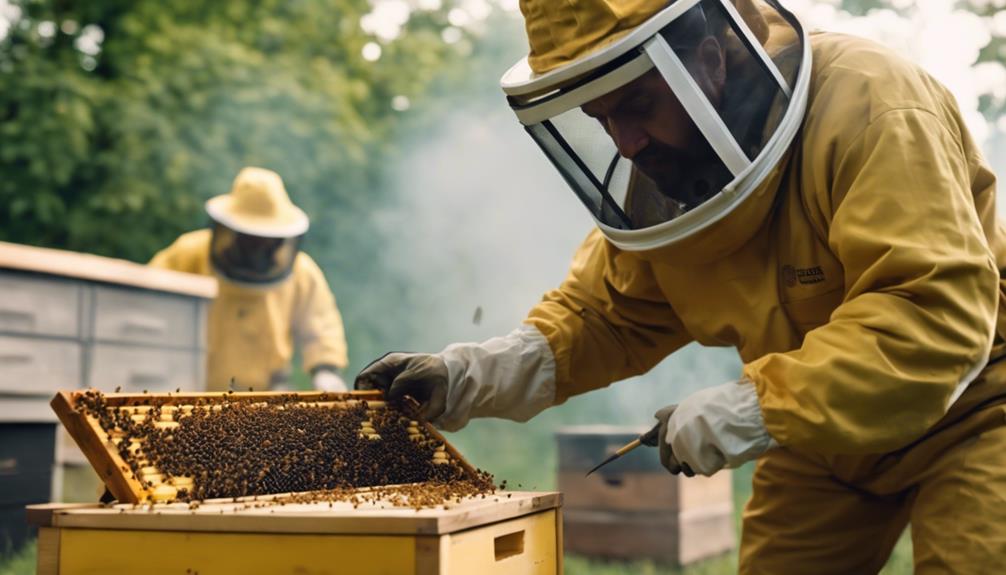
When managing Carniolan bee aggression, understanding their defensive behaviors is key to maintaining hive health and safety during inspections. Here are three tips for effectively handling their aggression:
- Utilize Smoke: Just like a BBQ master uses smoke to keep things under control, a puff of smoke in the hive can calm down these feisty Carniolans during inspections.
- Stay Calm: Bees can sense fear, so channel your inner zen master and approach the hive confidently. Your calm demeanor can help prevent any escalated aggression.
- Be Respectful: Remember, these bees are just protecting their home. By moving slowly and gently, you show them the respect they deserve, making the inspection smoother for both you and your buzzing friends.
Benefits of Carniolan Bees
Carniolan bees offer numerous advantages due to their exceptional hygienic behavior and extended lifespan, making them a valuable asset for hive health and productivity. Their diligent cleaning habits reduce the risk of diseases and pests, contributing to overall hive well-being.
With a longer lifespan compared to other bee species, Carniolan bees guarantee sustained productivity within the colony, benefiting both beekeepers and the environment. Additionally, their role in pollination is essential for supporting agricultural crop yields and maintaining ecosystem biodiversity.
Beekeepers appreciate their ease of management and rapid spring buildup, making them a popular choice for those looking to maintain healthy and thriving hives. Conservation efforts play a significant role in preserving the genetic diversity and purity of Carniolan bee populations, highlighting their importance in maintaining ecosystem balance.
Disease Resistance in Carniolan Bees
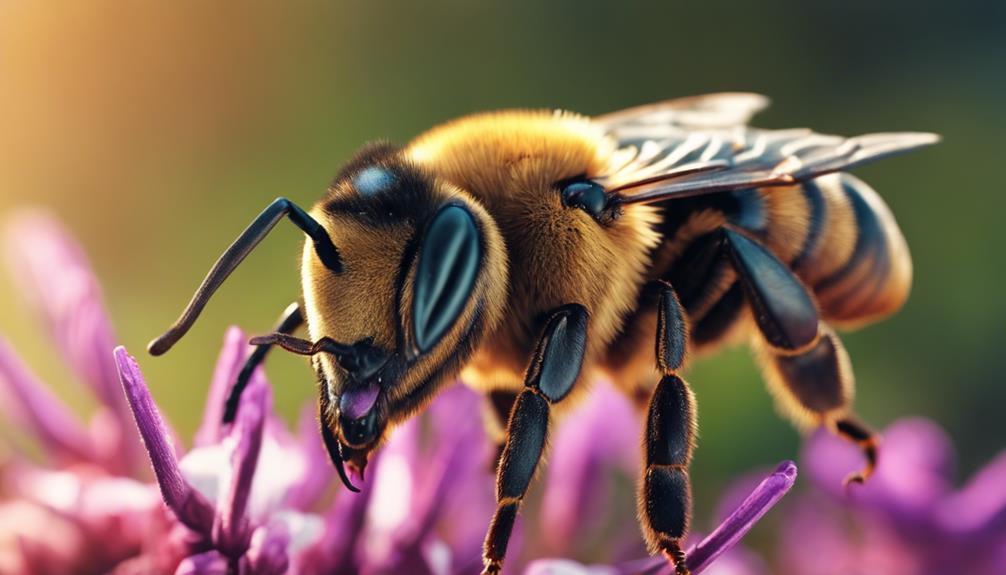
With their high disease resistance capabilities, Carniolan bees stand out as formidable defenders against common bee ailments like American foulbrood and chalkbrood. Here are three fascinating facts about their disease resistance:
- Genetic Traits: Carniolan bees possess unique genetic traits that equip them with the ability to combat various pathogens and parasites effectively. These traits have been honed through generations of selective breeding, making them resilient to many common bee diseases.
- Hygienic Behavior: One of the key factors contributing to the disease resistance of Carniolan bees is their hygienic behavior. They exhibit a remarkable tendency to remove diseased brood from the hive promptly, preventing the spread of infections and maintaining the overall health of the colony.
- Natural Defense Mechanisms: Research has revealed that Carniolan bees have natural defense mechanisms against specific threats, such as Nosema ceranae, a prevalent gut parasite in bees. This innate ability to fend off pathogens reduces the reliance on chemical treatments, benefiting both the bees and beekeepers.
Foraging Efficiency of Carniolan Bees
Their remarkable foraging efficiency distinguishes Carniolan bees as highly productive pollinators in various environmental conditions. These bees excel at gathering nectar, even on cool and overcast days, which sets them apart in honey production.
Their ability to collect nectar efficiently contributes significantly to the hive’s overall productivity. Carniolan bees are known for their strong foraging behavior, ensuring that they maximize the collection of resources for the colony.
This proficiency in foraging allows them to outperform other bee species, such as Italian bees, in terms of honey production. Whether it’s sunny or cloudy, Carniolan bees are always on the move, making the most out of every opportunity to gather nectar and contribute to the hive’s success.
Swarming Tendencies in Carniolan Bees
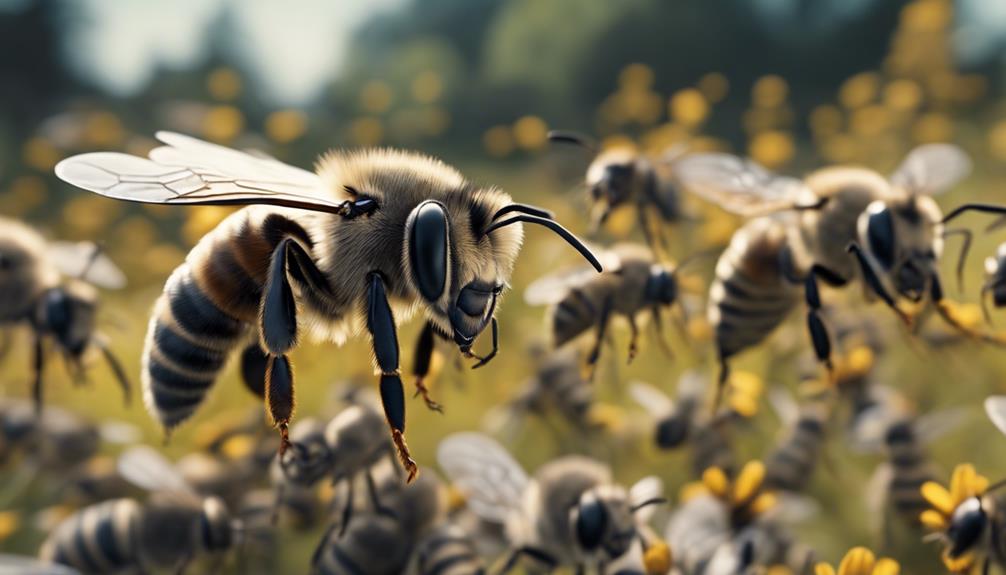
Carniolan bees are renowned for their swarming behavior, which can pose challenges for beekeepers. Understanding the swarming patterns and implementing effective prevention strategies are key to managing Carniolan hives successfully.
Swarming Behavior Patterns
Due to their genetic predisposition, Carniolan bees demonstrate a heightened propensity for swarming compared to Italian bees, exhibiting this behavior earlier in their colony development. Their rapid brood production and colony expansion contribute to this early swarming tendency, making swarm prevention essential for beekeepers. Understanding the swarming behavior patterns of Carniolan bees can help manage colonies effectively.
- Carniolan bees tend to swarm in their first year, requiring beekeepers to be proactive in implementing swarm prevention strategies.
- The rapid brood production of Carniolans can trigger swarming behavior sooner than in other bee species, necessitating early intervention.
- Their natural inclination for colony expansion means that monitoring hive conditions and queen activity is crucial to prevent swarming events.
Swarm Prevention Strategies
Implementing proactive measures to prevent swarming in Carniolan bees is essential for effective hive management. Due to their genetic traits, Carniolan bees have a higher tendency to swarm, especially in their first year. To tackle this, employing swarm prevention strategies becomes vital.
Regular monitoring and maintaining ideal bee space within the hive are key steps to deter swarming events. Keeping bee space at around 80% can significantly reduce the risk of swarming in Carniolan colonies. By carefully observing their behavior and hive conditions, beekeepers can preemptively address any signs of swarming, ensuring the well-being and productivity of the Carniolan bees.
These strategies not only benefit the bees but also contribute to a harmonious beekeeping experience.
Carniolan Bees in Beekeeping Practices
In beekeeping practices, dealing with the Carniolan bees’ aggressive nature requires strategic handling techniques. When working with these bees, it’s essential to approach them calmly and confidently to establish trust.
Here are some tips for managing Carniolan bees effectively:
- Utilize smoke: Carniolan bees, though more aggressive, respond well to the calming effects of smoke. This tool can help keep them calm during inspections or hive manipulations.
- Wear protective gear: Ensuring you have the right protective gear, such as a beekeeping suit and gloves, is vital when dealing with Carniolan bees. This gear provides a physical barrier and boosts your confidence while working with them.
- Be observant: Understanding the behavior of Carniolan bees is key. By observing their actions and reactions, you can anticipate their responses and adjust your beekeeping practices accordingly.

Hello! My name is Noel Calvin. I graduated from UCLA and now work as a writer at Launch Ninjas. I write blog posts that inspire and guide our readers in their entrepreneurial pursuits. I live in Pleasantville, NJ, with a peaceful yet lively atmosphere that inspires me.
Writing stories is more than just a job for me. It allows me to share my observations and satisfy my curiosity about the world. I combine my analytical skills with creative enthusiasm to delve into technology trends and startup stories. But my life isn’t limited to screens and keyboards. I value loyalty, passion, and a touch of old-fashioned charm, which I infuse into every narrative I create.
I love spending time in my garage, jamming with my band when I’m not writing. Playing the guitar and singing bring me immense joy. I also enjoy capturing ordinary and extraordinary moments through my camera lens and exploring new culinary adventures that excite my taste buds. I’m always seeking new experiences.
My family is very important to me. Joyful Sunday brunches filled with laughter and intense board game nights keep me grounded, reminding me of life’s simple pleasures.
In my world, every moment is an opportunity for discovery. Every discovery is a story worth sharing, whether a heartfelt moment at home or the pulse of technological innovations. Join me as I navigate through life, one blog post, one guitar strum, and one heartwarming family dinner at a time.

